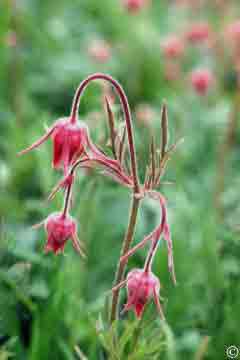 |
Prairie Smoke, (Old Man's Whiskers), Geum
triflorum var. ciliatum.
“Geum” is an old Latin name for avens—the common name
for this genus. The species name, triflorum, is easy; the flowers
grow three to a stem. Given its nodding, vase-like shape, the reddish color
of its five petals, and its spreading recurved bracteoles (accessory sepal
like leaves), the plants are easily identified. Prairie smoke is a common
perennial in our area, found at least as high as treeline and blooming often
in large patches in mid– to late spring. Another common name for the
prairie smoke is “old man’s whiskers.” Lewis and Clark gathered
Geum triflorum—a plant previously unknown to science--on
Idaho's Weippe Prairie, June 12, 1806 during their return journey. |
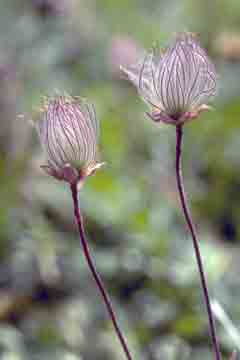 |
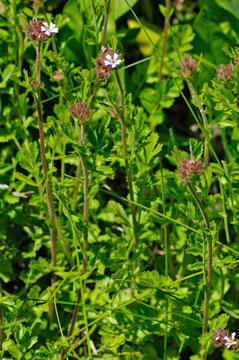 |
Pinewoods honeydew, or horkelia, Horkelia
fusca Lindl. (left, right). Horkelias,
named for a German physiologist, Johan Horkel (1769-1846) seem rather uncommon,
as we had not encountered the plant prior to late spring of 2009 growing
in a meadow near the Sun Valley resort. Several varieties have been described,
distinguished chiefly by the shape of the leaves. The plants are rather tall,
with leafy stems, and a very congested flower cluster born at the top. The
leaves are rather similar to those of potentillas, the flowers are small
and, in our variety white (possibly var. capitatum (Lindl.) Peck),
although pink flowers are seen in other varieties. The species
name, fusca from the Latin, means "fleeting," or "rapidly
withering." |
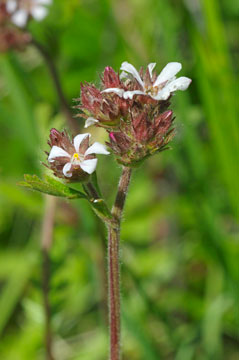 |
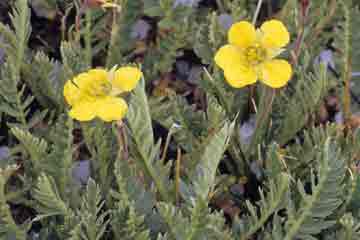 |
Ross’s avens, Geum rossii
(R. Br.) Ser. var. turbinatum (Rydb.) C. L.
Hitchc. (left) Ross's avens is a yellow-flowered plant
that bears little resemblance to the geum shown above (although the
leaves are similar). It grows from mid-elevations (where it is a taller
plant) to well above treeline. Pinnatifid (feather-like) leaves
help to identify it, as do purple-tinged stems and calyces. Only
var. turbinatum with a raised central disk is found in Idaho.The name
rossii honors arctic explorer Sir James Clark Ross (1800-1862).
Sheep cinquefoil, Potentilla
ovina Macoun ex J. M.
Macoun (right) has pinnate leaves that arise mostly from the base of
the plant; these have small, tightly ranked, furred leaflets. It is a small
creeping plant found from montane to alpine elevations. The yellow flowers
are similar to those of other potentillas. Macoun, who described this plant,
found it on Sheep Mountain in British Columbia, and gave it the name
ovina, a word that means “of sheep.” Several similar low-growing
potentilla grow in our mountains; their identification can be difficult.
|
 |
 |
Slender cinquefoil, Potentilla
gracilis Douglas ex Hook.
Jeps. (left, right). There are at least four varieties
of this plan classified by differences in their leaves: e.g. how deeply indented
the lobes of the leaflets are, how much hair grows on their surfaces, etc.
All have palmately compound leaves with five to nine toothed pinnate
(feather-like) leaflets and five-petaled yellow flowers with a central disk.
The plants are fairly tall and commonly bloom in late spring and early summer.
Var. brunnescens, characterized by its frilly, fern-like leaflets
is shown on the right.. Slender cinquefoils grow as one variety
or another throughout the West, north to Alaska, in our northern tier states
as far east as the midwest, and in most Canadian provinces.The species name,
gracilis, means “slender.”
|
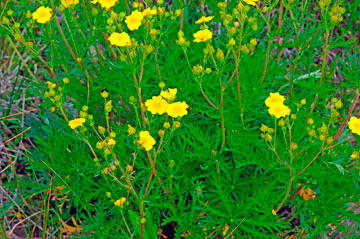 |
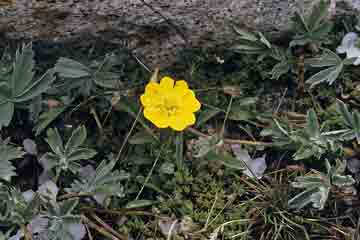 |
Early cinquefoil, Potentilla
concinna Richards (left).
The early cinquefoil's leaves vary from palmate (as shown here) to pinnate.
The individual leaflets are toothed at the ends. The grayish undersurface
of its leaves, are covered with downy, whitish hairs. The plant was collected
in 1820 by John Richardson, physician-naturalist with the first Franklin
expedition, on the Saskatchewan River in Canada. The name concinnus
means “neat.” (Photographed on Mt. Borah in
the Lost River Range.) |
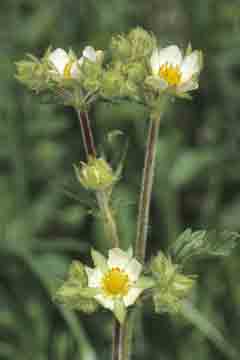 |
Cliff drymocallis, Drymocallis
pseudorupestris
(Rydb.) Rydb. var. saxicola Ertter (left).
Until recently, this wildflower was classified as Potentilla
glandulosa Lindl. with the common name “sticky cinquefoil,”
and so identified in guide books. Recent studies show, however, that the
plant is not related to the potentillas. Var. saxicola is common in
Idaho where it grows as high as treeline in reduced form (right). The
species, as one variety or another, is found in most states and provinces
west of the Mississippi River. The name drymocallis, from the Greek,
means “wood beauty”; the Latin name, saxicola, means
“mountain (or cliff) dwelling.,” reflecting this variety’s
growth preference. The plant's foliage and stems are noticeably sticky. |
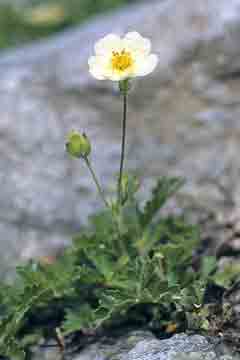 |
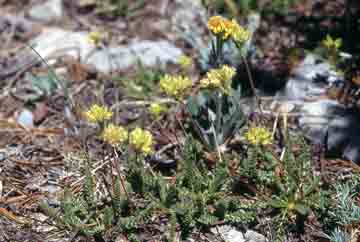 |
Gordon’s ivesia, Ivesia
gordonii (Hook.) Torr. & A. Gray (left)
is found at high elevations throughout Idaho. Pale yellow flowers form heads
on the ends of several long stems. The petals are glossy giving the flower
heads a glistening appearance. The central portion of the flower—the
“hypan”—is turbinate. Its leaves are pinnate, made up of very
closely ranked small leaflets. Once one knows the plant it is surprising
how often it is encountered on rocky alpine terrain. (The tall plant
in the background is an unidentified composite). . A rare species, Ivesia
tweedyi Rydb., grows in mountains near Coeur d’Alene. Dr. Eli Ives,
(1779-1861), for whom the genus was named, was a physician and
botanist.
Kelseya, Kelseya uniflora (S. Watson)
Rydb. (right) is an early flowering, mat-forming alpine
plant, the only one in its genus. Though uncommon, it has spread around the
world as a cultivated rock garden plant. Kelseyas spread over
rocks forming a carpet of tiny blue-gray leaves dotted with minute pink and
white flowers. Kelseya uniflora was named for Rev. Frank Duncan
Kelsey (1849-1905), of Helena, Montana, who first collected the plant. |
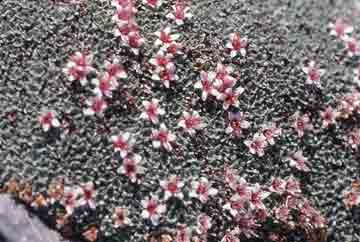 |
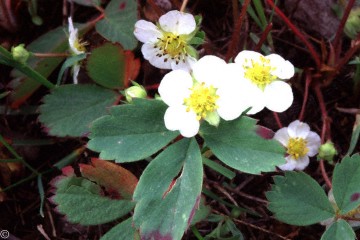 |
Wild strawberry, Fragaria
virginiana Mill var.
glauca (S. Watson) Staudt (left, right). Wild strawberries
are found in every part of North America. They occur at all elevations in
our mountains, even above treeline. Their flowers are large, with five
separated petals, and many anthers and stigmas arising from a central
receptacle. Fruiting plants are not common, but when found, they are
unmistakably strawberries, in taste and appearance. Two varieties occur in
Idaho. The plant shown here has smooth, almost hairless leaves. The other
variety, var. platypetala, has larger flowers and furry leaves and
stems. The name, Fragaria, was derived from
fraga the Latin word for “strawberry.” |
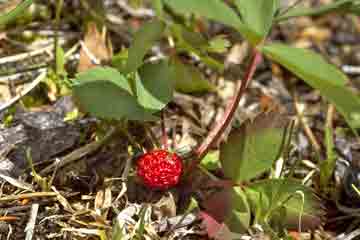 |
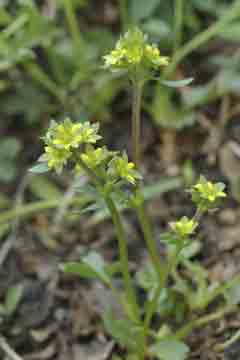 |
Sibbaldia, Sibbaldia
procumbens L. (left) is the only North American
plant in its genus although five species, including this one, grow in Eurasia.
The sibbaldia is an alpine plant in the United States. It is far smaller
than the illustration suggests and may be identified by tiny flowers borne
in small clusters at the ends of stout stems. There are five prominent sepals
and as many narrowly attached petals. Its basal leaves are strawberry-like,
with several teeth at the end of each of three leaflets. Sir Robert Sibbald
(1641-1722) was a prominent physician of Edinburgh with an interest in botany.
He published a natural history of Scotland in which he described this plant.
Linnaeus took note of Sibbald’s contribution and named it
Sibbaldia.
Western burnet, Sanguisorba
annua (Nutt.) Nutt. (right) has dense clusters
of tiny flowers borne, on several branching stems. The stem is leafy in its
lower part with fern-like pinnate leaves. The burnet grows in our mountains
at least as high as the montane zone. It prefers open fields. The name
“burnet” has been used for centuries for a European species; the
word means “brown,” reflecting the color of post-mature flowerheads.
Sanguisorba, in turn, implies “blood absorbing” as the plants
were thought to have styptic properties. |
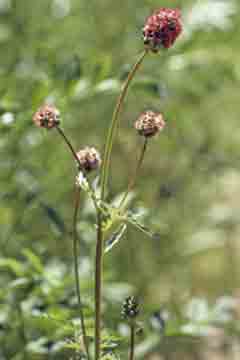 |
















